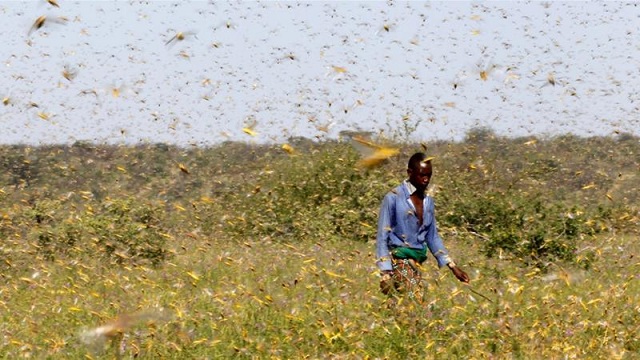
Kampala, Uganda | XINHUA | The East Africa region is facing an unprecedented triple food security threat caused by the combined effects of recent severe floods, the ongoing COVID-19 pandemic and the upsurge of desert locusts, the United Nation Food and Agricultural Organization (FAO) said.
The FAO, in a joint position statement issued together with the Intergovernmental Authority on Development (IGAD) and the World Food Programme (WFP) on late Tuesday, stressed that “urgent action is required to prevent a major food crisis in Eastern Africa.”
It emphasized that there is an increased risk of below-average rains during the upcoming October to December season, which could further threaten food security and livelihoods across the region.
According to FAO, even before these current challenges, Eastern Africa was considered among the most food insecure regions of the world, with nearly 28 million people in food insecurity crisis in 2019, or 20 percent of the total severely food insecure population across the world.
It also stressed that an estimated 9 million children under the age of five suffer from acute malnutrition, including 2 million facing severe acute malnutrition.
The IGAD region is also one of the world’s leading sources and hosts of internally displaced persons and refugees and asylum seekers who, due to limited livelihood opportunities and degraded coping mechanisms, are particularly vulnerable to food insecurity and malnutrition, according to the FAO.
The UNHCR estimates that the region currently hosts about 8 million internally displaced persons and 4 million refugees and asylum seekers.
“In this context of already high levels of food insecurity, the current triple threat facing vulnerable populations across Eastern Africa is expected to drive significant food security deteriorations in the absence of urgent action that protects lives and livelihoods, strengthens food systems, builds resilience across all vulnerable communities, and improves early warning systems and preparedness,” the statement read.
Between March and May 2020, heavy rainfall across the region resulted in widespread flooding and landslides across Djibouti, Ethiopia, Kenya, Somalia and Uganda. According to IGAD, some 2.4 million people were affected, including 700,000 who were displaced and over 500 who were killed.
This is in addition to previous flooding between October and December 2019, which affected 3.4 million people across the region, according to FAO.
Forecasts of above-average rainfall between June and September 2020, particularly across western Ethiopia, eastern South Sudan, Sudan, western Kenya, northern and central Uganda increases the risk of additional flooding during the next several months.
Favorable weather and vegetation conditions across the Eastern African region in late 2019 to mid-2020 contributed to the worst desert locust upsurge in over 25 years, affecting all IGAD countries with varying levels of destruction to crops and pastureland.
Kenya, Somalia, and Ethiopia are of the highest concern, with FAO indicating that up to 2.5 million people are becoming severely food insecure as a direct consequence of desert locust in the IGAD region.
Following the first COVID-19 cases in the region in early 2020, governments imposed certain measures which, though necessary, have had food security and nutrition implications. As of July 22, the IGAD region has seen over 47,000 COVID-19 cases.
“The resulting economic slowdown has led to significant declines in income levels for many vulnerable urban and rural cropping and pastoralist populations, compromising their access to food due to reduced purchasing power,” it was noted.
The FAO and its partners also stressed that COVID-19-inflicted movement restrictions and border lockdowns are also disrupting food logistics and supply chains, which in turn has reduced food availability and increased post-harvest losses in parts of the region.
“Restrictions are impacting the movement and supply of agricultural inputs, including labor, fertilizers, pesticides and equipment, thus posing serious challenges to food production,” the joint statement read.
As of July 22, 2020, the additional humanitarian requirements, on top of government resources, for food security, nutrition and livelihood support are 3.4 billion U.S. dollars for seven IGAD member states that are Djibouti, Ethiopia, Kenya, Somalia, South Sudan, Sudan, and Uganda.
“These requirements are just 33 percent funded, leaving a funding gap of 2.3 billion U.S. dollars, as per country-level humanitarian response plan, flash appeals, inter-sectoral COVID-19 response plans, and the global COVID-19 humanitarian response plan,” according to the joint statement.
“This requires urgent attention considering that many governments will likely face significant difficulties responding to this large-scale crisis on their own,” it added.
******
XINHUA
 The Independent Uganda: You get the Truth we Pay the Price
The Independent Uganda: You get the Truth we Pay the Price


